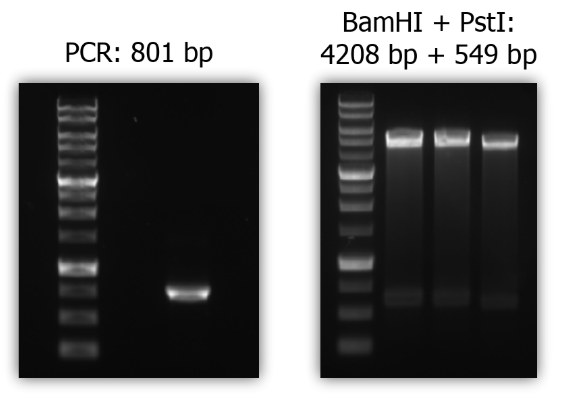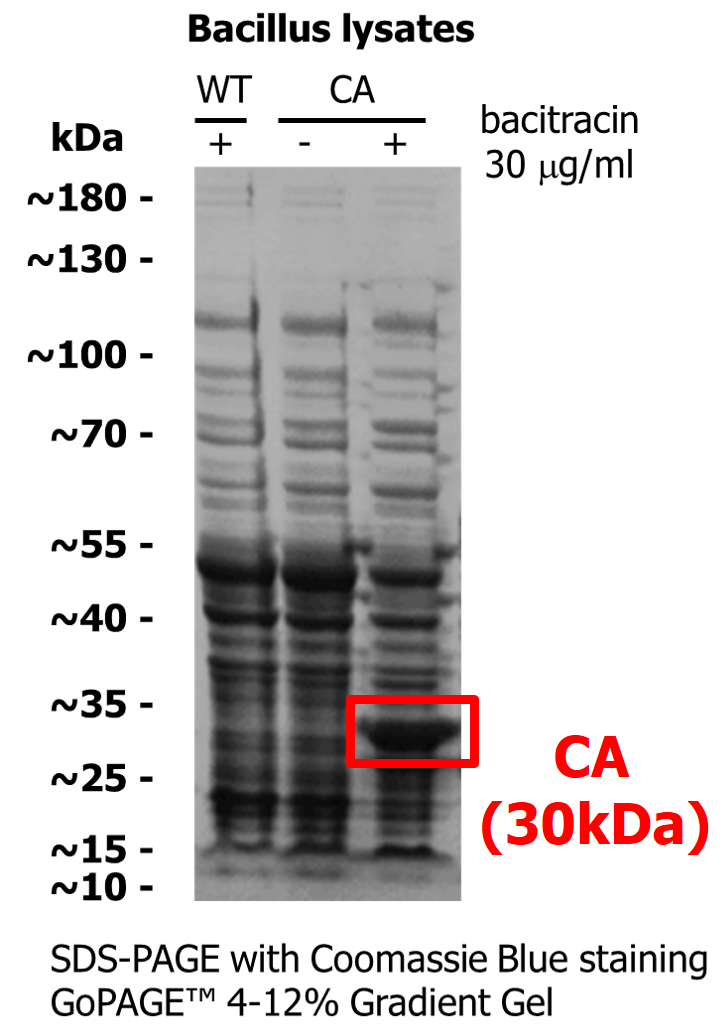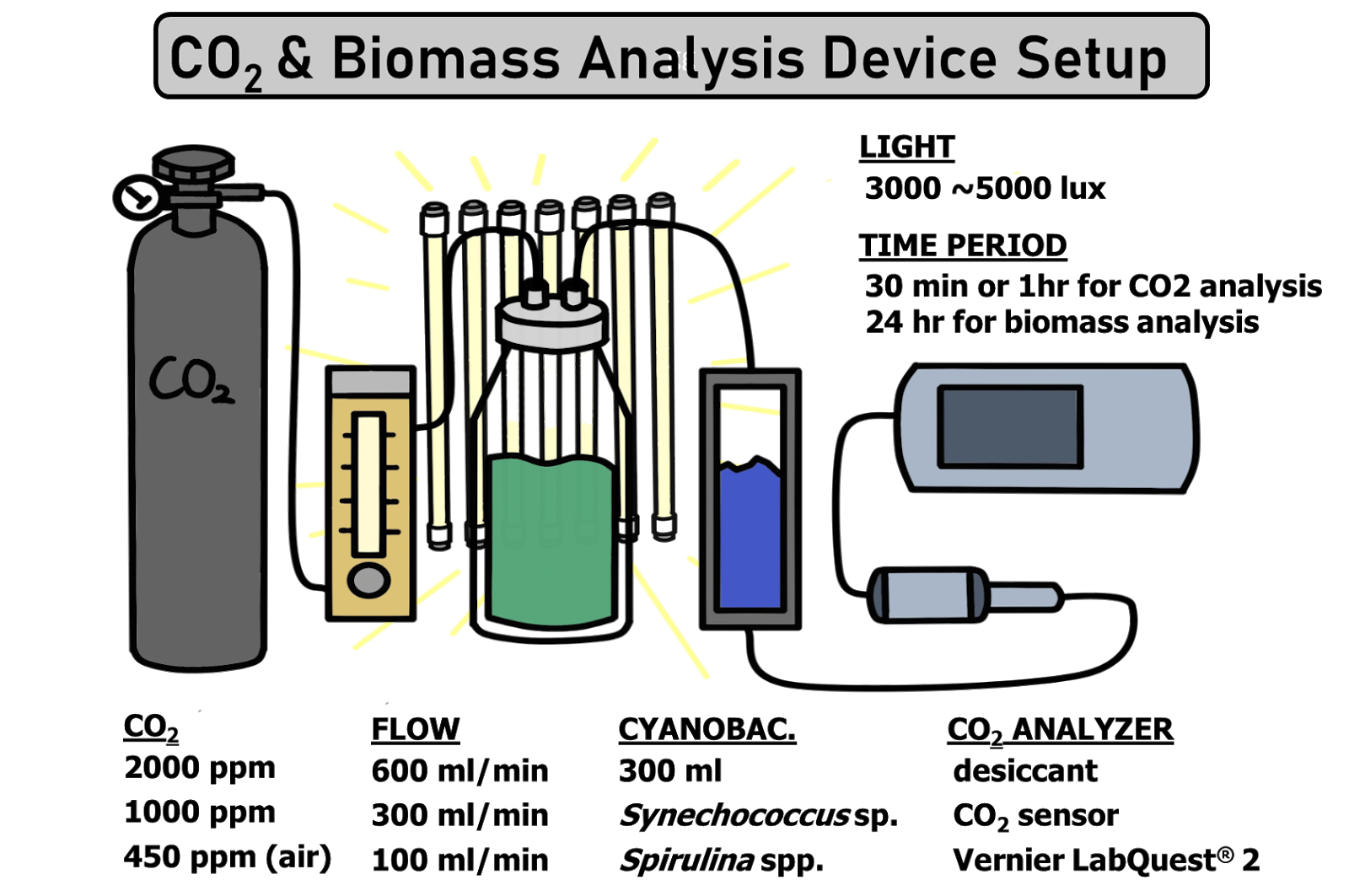Part:BBa_K2932003
PliaI + RBS + CA + terminator
Biological Function
Carbonic anhydrase (CA) is an enzyme which can be commonly seen in human erythrocytes, it helps the respiratory system to remove CO2 by increasing CO2 solubility in the bloodstream. The CA catalyzes the gas form of CO2 to the ionic form of bicarbonate as a dissolved inorganic compound.

Gene Cloning and Protein Expression
Human carbonic anhydrase II is well-studied and is one of the most efficient enzymes catalyzing the rapid conversion of CO2 to bicarbonate (HCO3-), and we used it to improve the dissolution rate of CO2 in the algal culture medium. We got the gene sequence from NCBI and synthesized the DNA fragment by Twist Bioscience. We made a Basic BioBrick Part of CA. Then, to make a Composite BioBrick Part for testing the function, DNA fragments were amplified by PCR and assembled with a terminator, followed by inserting to PliaI-RBS/pSB1C3. CA was tagged with 6xHis at C terminus for further protein purification if needed.
Construct of PliaI-RBS-CA-Tr/pSB1C3
To express genes of CA in Bacillus subtilis, we transfer the DNA fragments of PliaI-RBS-CA-Tr to pBS0E vector and transformed Bacillus subtilis 168 with the resulting plasmids.
Protein induction procedure
↓ culture Bacillus Subtilis 168 carrying the plasmid of PliaI-RBS-CA-Tr/pBS0E in LB + Amp (100ug/ml) O/N at 37°C, shaking at 170 rpm, supplied with 60μM of ZnSO4
↓ transfer 3 ml to 50 ml LB with Amp and ZnSO4 in 250 ml flask
↓ measure OD650
↓ shake at 200rpm,37°C until OD650 between 0.5~0.7
↓ add 400μM of ZnSO4 and 50μl of 30μg/ml Bacitracin for induction at 25°C, shaking at 100 rpm for 18.5 hr
After protein induction by bacitracin, total lysates of Bacillus expressing were subjected to SDS-PAGE and stained with Coomassie blue. CA protein was observed after induction around 30kDa as the same size of predicted molecular weight.
CA protein purification
↓ Equilibrate Ni-NTA resin in the column with 20mM Tris-HCH, 200mM NaCl, pH7.5
↓ Load protein lysates onto the column. The flow-through was collected.
↓ Wash the column with 20mM Tris-HC, 200mM NaCl, 5mM imidazole, pH7.5 The wash-through was collected.
↓ Elute the column with 20mM Tris-HC, 200mM NaCl, 20mM imidazole, pH7.5. The Elution #1 was collected.
↓ Elute the column with 20mM Tris-HC, 200mM NaCl, 200mM imidazole, pH7.5. The Elution #2 was collected.
↓ Elute the column with 20mM Tris-HC, 200mM NaCl, 500mM imidazole, pH7.5 The Elution #3 was collected.
The total lysates, flow-through, wash-through and Elution #1, #2, #3 were subjected to SDS-PAGE and Coomassie Blue staining as well as Western Blotting with the anti-His antibody. The data presented below gave a clear evidence of the CA protein induction, expression and purification. (The work of purification, SDS-PAGE and WB for CA protein was collaborated with team CSMU-Taiwan)
CA Functional Assay
To test CA function, we added the purified CA into ddH2O and pump the ambient CO2 (~450 ppm) into the water. The pH level and CO2 dissolution rate were measured by pH meter and CO2 sensor, respectively. Based on the catalyzation reaction of CA, if CA works, CO2 level will drop and pH value of water should decrease.

The data was presented below. The left figure showed the CO2 fastly dissolved into water and CO2 elevated to the normal level after 8 min due to CO2 saturation in the water. The right figure indicated the pH value of water supplemented with CA decreased quicker than the one without CA, confirming the function of CA.
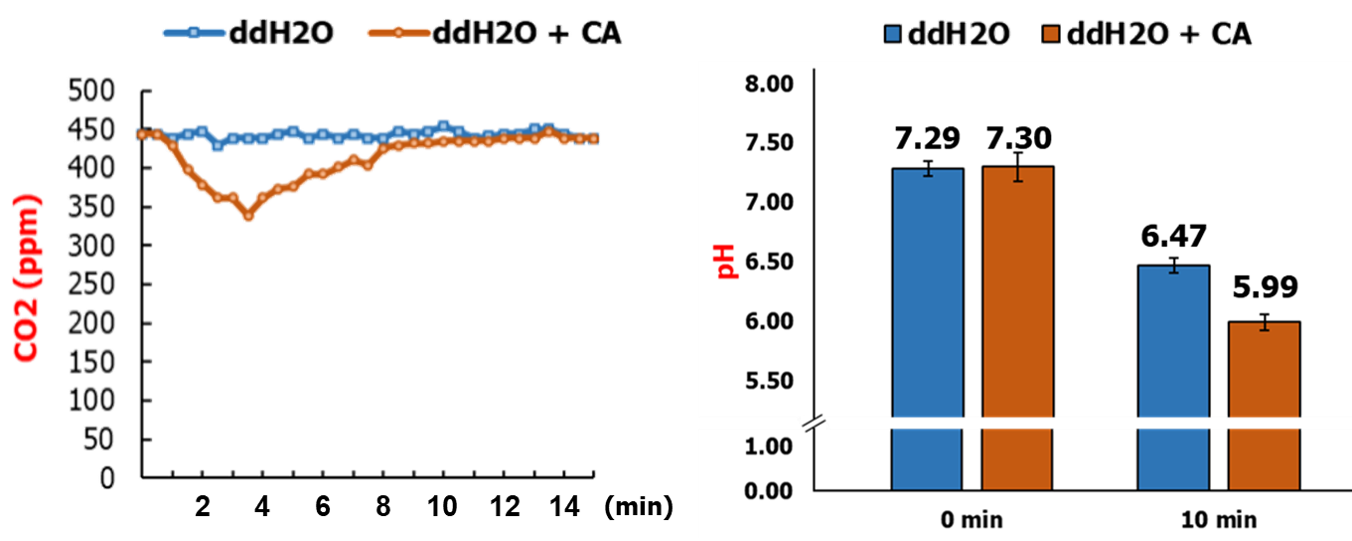
Microalgae Purification System Demonstration
CO2 analysis device setup
To determine the efficiency of our system, the CO2 & biomass analysis device was set up. We used parameters of CO2 concentrations, air flow rate, algae culture volume, light intensity and test periods as indicated in the schematic diagram.
The CO2 consumption and the biomass generation are two indexes for the efficiency of our system and should be improved in the presence of active CA.
We tested two cyanobacterial strains. One is lab strain, Synechococcus elongatus PCC7942, obtained from National Chiao Tung University. The other is an edible strain, Spirulina spp., purchased as food supplements from the pharmacy store. We ground the pill made of Spirulina into powder and put it into BG-11 media in the same condition of culturing the lab strain.
Experiment #1
Strain: Synechococcus elongatus PCC7942
Index: CO2 consumption
Enzyme: 1ml of Bacillus raw lysates containing CA (CA was estimated at 50mg)
Starting OD730 of algae: 0.5
Culture volume: 100 ml or 300ml of BG-11
Input of CO2: 1000 ppm or 2000 ppm
Air flow rate: 300 ml/min or 600 ml/min
Light: 5000 lux
Time period: 1hr
Result:
When providing 1000 ppm of CO2, 100 ml of algae consumed 37.2% or 59.6% CO2 without or with CA, respectively. The CA enhance 60.1% efficiency of CO2 removal. However, 300 ml of algae absorbed more CO2 (84.4% without CA, 90.3% with CA) but with ignored CA function. When increasing CO2 input to 2000 ppm, 300 ml of algae with CA improved 33.3% of CO2 consumption compared to the group without CA. If increasing more CO2 input by tuning up air flow rate from 300 ml/min to 600 ml/min, a significant improvement (78.3%) was obtained by algae culture in the presence of CA.
Experiment #2
Strain: Synechococcus elongatus PCC7942
Index: Biomass generation
Enzyme: 1ml of Bacillus raw lysates containing CA (CA was estimated at 50mg)
Starting OD730 of algae: ~0.5
Culture volume: 300ml of BG-11
Input of CO2: ambient CO2 (~450ppm)
Air flow rate: 300 ml/min or 600 ml/min
Light: 3000 lux
Time period: 24hr
Result:
The table below presented the OD730 values of Synechococcus growing in the absence or presence of CA.
According to the equation of the conversion of OD730 value to Biomass (g/L/day)(Ashley E. Beck, et al. Processes (2018)), we obtained the data which showed the generation of biomass in the culture with CA increased 3.24x more than the culture without CA. The result further confirmed that the increased CO2 consumption which is facilitated by CA is converted to biomass by algal CO2 fixation.
Experiment #3
Strain: Spirulina spp.
Index: CO2 consumption
Enzyme: 1ml of Bacillus raw lysates containing CA (CA was estimated at 50mg)
Starting OD730 of algae: ~0.5
Culture volume: 300ml of BG-11
Input of CO2: 850 ppm
Air flow rate: 600 ml/min
Light: 5000 lux
Time period: 30 min or 1hr
Result:
Our microalgae system was tested with an edible strain, Spirulina. In consistent with the result in the data of Synechococcus, the Spirulina with CA consumed CO2 more efficiently than ones with WT bacterial lysates. And the improvement because of CA can be maintained at least for 1 hr.
The result shown below is one of the representative data.
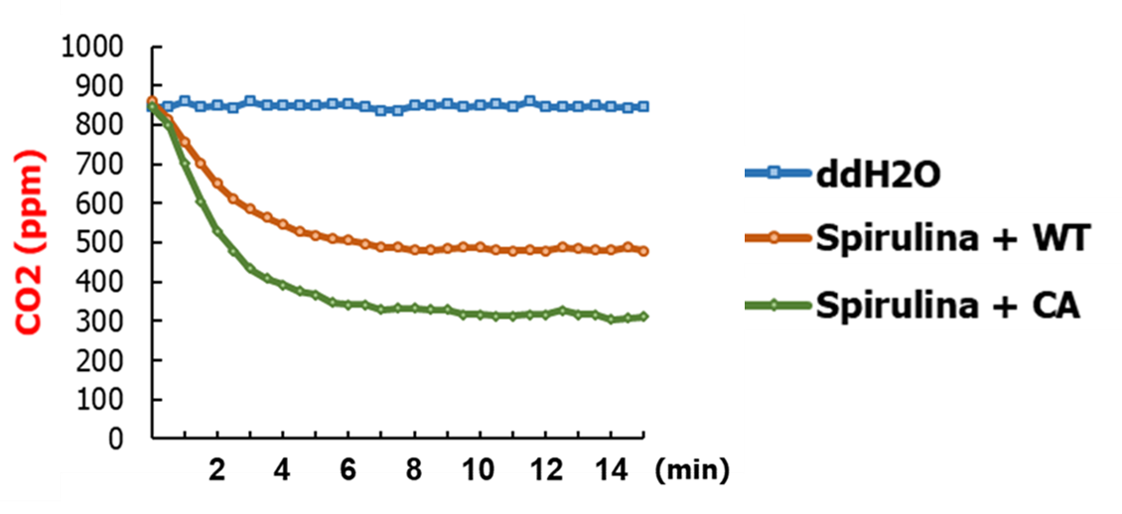
Summary
In our experiments, we successfully demonstrated the enzyme function of the purified CA and Bacillus lysates containing CA. In addition, the CO2 consumption was improved significantly in the microalgae purification system with Synechococcus and Spirulina, suggesting that this system is working and has a potential for many applications.
Discussion
Carbonic anhydrase (CA) application in CO2 capture and sequestration was studied intensively. Joel K. J. Yong, et al. studied in 2015 about CO2 capture in the chemical absorption process using CA. The CA is immobilized within the gas absorber and enhance CO2 capture performance. A review paper by Madhumanti Mondal, et al. in 2016 summarizes using CA in biological carbon capture through microalgae. In our study, we applied this technique to our system and engineered Bacillus to produce CA based on synthetic biology. And we make an effort to bring the product and application to the real world.
References
- Cornelia Geers, and Gerolf Gros “Carbon Dioxide Transport and Carbonic Anhydrase in Blood and Muscle“ Physiological Reviews - American Journal of Physiology. 2000; 80(2):681-715. doi: 10.1152/physrev.2000.80.2.681
- J. V. Moroney and A. Somanchi “How Do Algae Concentrate CO2 to Increase the Efficiency of Photosynthetic Carbon Fixation?” Plant Physiol. 1999 Jan; 119(1): 9–16. doi:10.1104/pp.119.1.9
- Philipp F. Popp, Mona Dotzler, Jara Radeck, Julia Bartels & Thorsten Mascher. "The Bacillus BioBrick Box 2.0: expanding the genetic toolbox for the standardized work with Bacillus subtilis" Scientific Reports 2017; 7(1):15058 doi: 10.1038/s41598-017-15107-z.
- Ashley E. Beck, Kristopher A. Hunt and Ross P. Carlson "Measuring Cellular Biomass Composition for Computational Biology Applications" Processes 2018, 6(5), 38; doi:10.3390/pr6050038
- Joel K. J. Yong, Geoff W. Stevens, Frank Caruso, Sandra E. Kentish "The use of carbonic anhydrase to accelerate carbon dioxide capture processes" Journal of Chemical Technology & Biotechnology 2015:90(1) doi:10.1002/jctb.4502
- Madhumanti Mondal, Saumyakanti Khanra, O.N. Tiwari, K. Gayen G.N. Halder. "Role of carbonic anhydrase on the way to biological carbon capture through microalgae—A mini review" American Institute of Chemical Engineers Environ Prog, 2016: 35:1605–1615, doi:10.1002/ep.12394
Sequence and Features
- 10COMPATIBLE WITH RFC[10]
- 12COMPATIBLE WITH RFC[12]
- 21COMPATIBLE WITH RFC[21]
- 23COMPATIBLE WITH RFC[23]
- 25COMPATIBLE WITH RFC[25]
- 1000INCOMPATIBLE WITH RFC[1000]Illegal BsaI site found at 698
| None |


